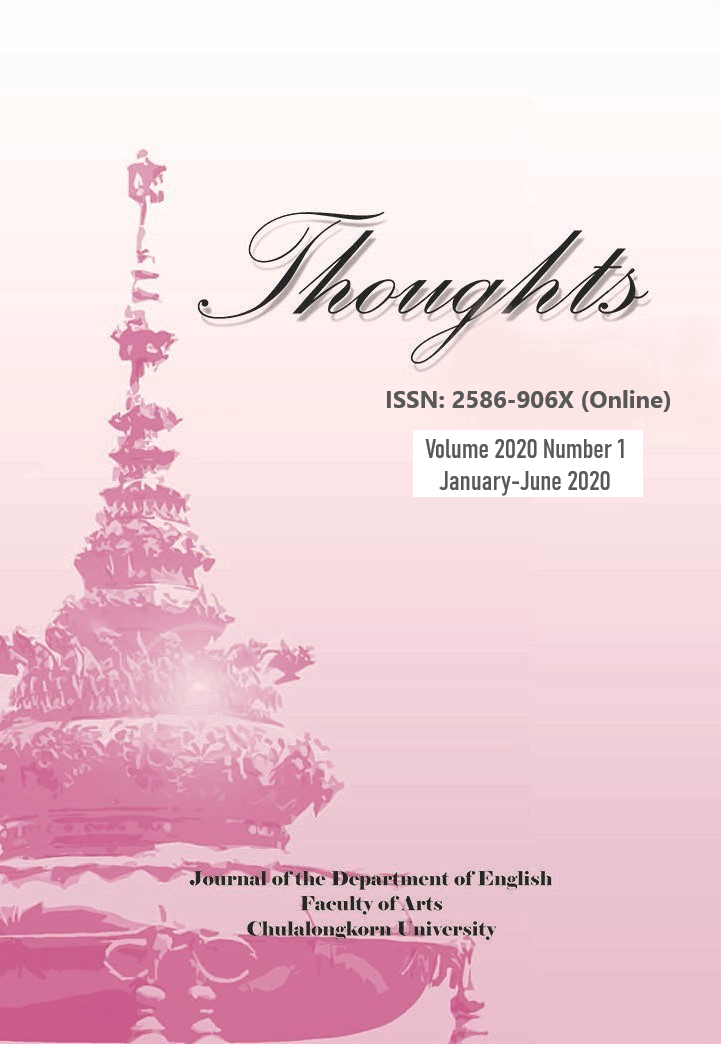Visual, vital, and vibrant: Artistic / aesthetic New Woman figures and Pre-Raphaelitism in late-nineteenth-century novels by women authors
DOI:
https://doi.org/10.58837/CHULA.THTS.2020.1.3Keywords:
the New Woman, Pre-Raphaelite paintings, late-nineteenth-century novels, Mary Ward, Lucas MaletAbstract
This research paper examines the New Woman figure by paying attention to her beauty which stands out through its reminiscence of Pre-Raphaelitism. A focus on Mary Ward’s Rose Leyburn, the girl violinist in Robert Elsmere (1888) and Lucas Malet’s Mary Crookenden, the talented art student in The Wages of Sin (1890), allows a fruitful comparison with six paintings by Dante Gabriel Rossetti. The analysis leads to a conclusion that Rose fits the appearance of these Pre-Raphaelite women particularly when considering her beauty that is not only visual but also vital and vibrant as they mobilise her and boost her confidence finally to gain her entrance into the public sphere. Mary, in contrast, may be matched with those Pre-Raphaelite women through her visual and vibrant beauty only since her association with the Virgin Mary, indeed part of her vital beauty, puts her at some distance from the other earthly counterparts.
References
Andres, S. (2005). The Pre-Raphaelite art of the Victorian novel: Narrative challenges to visual gendered boundaries. The Ohio State University Press.
Austin, L. M. (1987). Ruskin and the ideal woman. South Central Review, 4(4), 28-39.
Barringer, T. (2012). Reading the Pre-Raphaelites. Yale University Press.
Burdett, C. (2014, March 15). Aestheticism and decadence. The British Library. https://www.bl.uk/romantics-and-victorians/articles/aestheticism-and-decadence
Cambridge. (n.d.). Vibrant. In Cambridge dictionary. Retrieved January 2, 2020, from https://dictionary.cambridge.org/dictionary/english/vibrant
Cambridge. (n.d.). Visual. In Cambridge dictionary. Retrieved January 2, 2020, from https://dictionary.cambridge.org/dictionary/english/visual
Cambridge. (n.d.). Vital. In Cambridge dictionary. Retrieved January 2, 2020, from https://dictionary.cambridge.org/dictionary/english/vital
Denisoff, D. (2007). Decadence and aestheticism. In G. Marshall (Ed.), The Cambridge Companion to the Fin de Siècle (pp. 31-52). Cambridge University Press.
Dickens, C. (1850). Old lamps for new ones. Household Words, 1(12), 265-267.
Heilmann, A. (Ed.). (1998). The Late-Victorian Marriage Question: A Collection of Key New Woman Texts (Vol. 2). Routledge.
Herringer, C. E. (2008). Victorians and the Virgin Mary: Religion and gender in England, 1830-1885. Manchester University Press.
Kent, S. K. (1990). Sex and Suffrage in Britain, 1860-1914. Princeton University Press.
Khunpakdee, T. (2013). Individualism, the New Woman, and marriage in the novels of Mary Ward, Sarah Grand, and Lucas Malet [Unpublished doctoral dissertation]. University of London.
Machin, J. (2018). Weird fiction in Britain 1880-1939. Palgrave Macmillan.
Malet, L. (1891). The wages of sin (Vols. 1-3). Swan Sonnenschein and Co.
Mancoff, D. N. (2012). The Pre-Raphaelite language of flowers. Prestel.
Novels. (1888, April 28). [Review of the book Robert Elsmere, by Mrs. H. Ward]. Illustrated London News, 92, 465.
Prettejohn, E. (2007). Art for art’s sake: Aestheticism in Victorian painting. Yale University Press.
Robinson, M. (2012). The lives and works of the Pre-Raphaelites: An illustrated exploration of the Pre-Raphaelite Brotherhood, their lives and contexts. Hermes House.
Rossetti, D. G. (1849-1850). Ecce Ancilla Domini! [Oil on canvas laid on panel]. Tate Gallery, London.
_____. (1854-1881, unfinished). Found [Oil on canvas]. Delaware Art Museum, Wilmington.
_____. (1859). Bocca Baciata [Oil on panel]. Museum of Fine Arts, Boston.
_____. (1863). Fazio’s Mistress [Oil on panel]. Tate Gallery, London.
_____. (1871-1874). La Ghirlandata [Oil on canvas]. Guildhall Art Gallery, London.
_____. (1872). Veronica Veronese [Oil on canvas]. Delaware Art Museum, Wilmington.
Ruskin, J. (1851). The Pre-Raffaelites. In J. Delane (Ed.), The Times (London) (pp. 8-9). http://www.rossettiarchive.org/docs/n.gb1.1851.may.rad.html
Ruskin, J. (1865). Lecture II—Lilies: Of Queens’ Gardens. In Sesame and Lilies: Two Lectures Delivered at Manchester in 1864 (pp. 119-196). Smith, Elder & Co.
Seys, M. C. (2014). Double threads: reading dress, fashion, narrative and representations of femininity in Victorian popular literature [Unpublished doctoral dissertation]. The University of Adelaide.
Smith, L. (2013). Pre-Raphaelite poetry and painting. Northcote House Publishers Ltd.
The wages of sin. (1891, February 6). [Review of the book The Wages of Sin, by L. Malet]. The Literary World: Choice Readings from the Best New Books, with Critical Reviews, 43, 115.
Tobin, T. J. (2002). Charles Dickens and the Pre-Raphaelites. The Review of the Pre-Raphaelite Society, 10(2), 2-16.
Ward, Mrs. H. (1888). Robert Elsmere. Macmillan and Co.
Wilt, J. (2005). Behind Her Times: Transition England in the Novels of Mary Arnold Ward. University of Virginia Press.
Downloads
Published
Issue
Section
License
Copyright (c) 2020 Thoughts

This work is licensed under a Creative Commons Attribution-NonCommercial-NoDerivatives 4.0 International License.
Copyright by the Faculty of Arts, Chulalongkorn University.
Photocopying is allowed for internal, non-commercial use only. Photocopying for other uses or for purposes other than indicated must be permitted in writing from the Faculty of Arts, Chulalongkorn University.
All views or conclusion are those of the authors of the articles and not necessarily those of the publisher or the editorial staff.


